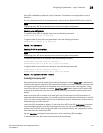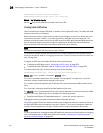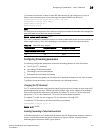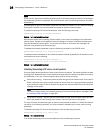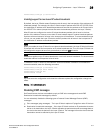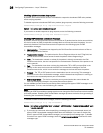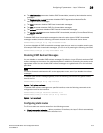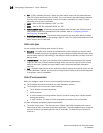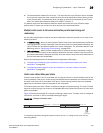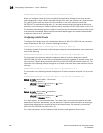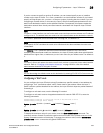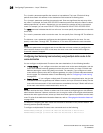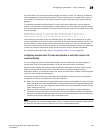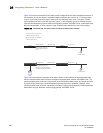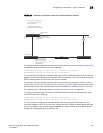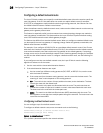
PowerConnect B-Series FCX Configuration Guide 821
53-1002266-01
Configuring IP parameters – Layer 3 Switches
26
• The administrative distance for the route – The value that the Layer 3 Switch uses to compare
this route with routes from other route sources to the same destination before placing a route
in the IP route table. This parameter does not apply to routes that are already in the IP route
table. The default administrative distance for static IP routes is 1.
The default metric and administrative distance values ensure that the Layer 3 Switch always
prefers static IP routes over routes from other sources to the same destination.
Multiple static routes to the same destination provide load sharing and
redundancy
You can add multiple static routes for the same destination network to provide one or more of the
following benefits:
• IP load balancing – When you add multiple IP static routes for the same destination to different
next-hop gateways, and the routes each have the same metric and administrative distance, the
Layer 3 Switch can load balance traffic to the routes’ destination. For information about IP load
balancing, refer to “Configuring IP load sharing” on page 829.
• Path redundancy – When you add multiple static IP routes for the same destination, but give
the routes different metrics or administrative distances, the Layer 3 Switch uses the route with
the lowest administrative distance by default, but uses another route to the same destination if
the first route becomes unavailable.
Refer to the following sections for examples and configuration information:
• “Configuring load balancing and redundancy using multiple static routes to the same
destination” on page 824
• “Configuring standard static IP routes and interface or null static routes to the same
destination” on page 825
Static route states follow port states
IP static routes remain in the IP route table only so long as the port or virtual interface used by the
route is available. If the port or virtual routing interface becomes unavailable, the software removes
the static route from the IP route table. If the port or virtual routing interface becomes available
again later, the software adds the route back to the route table.
This feature allows the Layer 3 Switch to adjust to changes in network topology. The Layer 3 Switch
does not continue trying to use routes on unavailable paths but instead uses routes only when their
paths are available.
Figure 128 shows an example of a network containing a static route. The static route is configured
on Switch A, as shown in the CLI example following the figure.
FIGURE 128 Example of a static route
The following command configures a static route to 207.95.7.0, using 207.95.6.157 as the
next-hop gateway.
207.95.7.69/24
207.95.7.7/24
Switch A
Switch B
207.95.6.188/24
207.95.6.157/24
e 1/2



